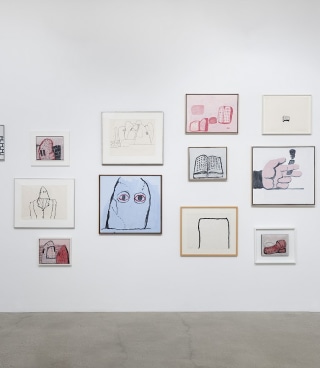Philip Guston: Works on Paper
‘It is the nakedness of drawing that I like. The act of drawing is what locates, suggests, discovers…’
Timothy Taylor Gallery is delighted to present an exhibition of works on paper by Philip Guston, one of the most important and influential American artists of the 20th Century. The exhibition traces Guston’s development on paper from the 1950s through to 1980 and the remarkable shift in his work from abstraction to figuration.
Primarily known as a painter, Guston received critical acclaim early on in his career as an Abstract Expressionist amongst contemporaries such as Jackson Pollock and Willem de Kooning. However, it was the medium of drawing and its implicit immediacy that best allowed him to explore and realise new ideas even, at significant points of his career, ceasing to paint altogether. The drawings and works on paper ushered in a dramatic reorientation in his work and offer us a unique insight into the mechanics of Guston’s mind and method.
With an evident proficiency for drawing from a young age and an admiration for Oriental mysticism, Guston sought a pure poetic abstract language. Works such as Leaving (1950) characterise this period with a rhythmic balance that is derived from the variations of linear ink strokes and contemplative composition. In the late 1960s, Guston stopped painting altogether, instead experimenting on paper with the dialectic nature of abstraction and figuration. During this time, he produced works of startling economy such as The Hill (1965) whose simple yet ambiguous forms hint at a repressed figuration. Increasingly frustrated with the apparent limits of abstraction and seeking a vehicle to realise his own experience of the world, Guston created a pictorial alphabet of tragicomic forms that typify his final decade and are now considered quintessentially ‘Guston’. Crude and cartoon-like shoes, books and irons pervade his work of the 1970s as well as macabre hooded figures alluding to Klansmen such as Untitled (Three Hoods) (1972). It was this vocabulary that allowed Guston to address the upheavals and civil unrest of the late 1960s.
Born Philip Goldstein in Montreal, Canada in 1913, Guston studied at the Otis Art Institute, Los Angeles having been awarded a scholarship in 1930. His work has been widely exhibited and was included in the influential The New American Painting organised by the Museum of Modern Art, New York (1958) that went on to travel around Europe. Since his death in 1980, aged 67, his work has been the subject of a number of major international retrospective exhibitions including Philip Guston: Peintures 1947 – 1979, Centre Pompidou Paris and Kunstmuseum Bonn (2000);Philip Guston: One-shot paintings, IVAM, Valencia (2001) and Philip Guston: Retrospective, Modern Art Museum of Fort Worth, Texas, USA, touring to the San Francisco Museum of Modern Art, California, The Metropolitan Museum of Art, New York and the Royal Academy of Arts, London (2003-04).






